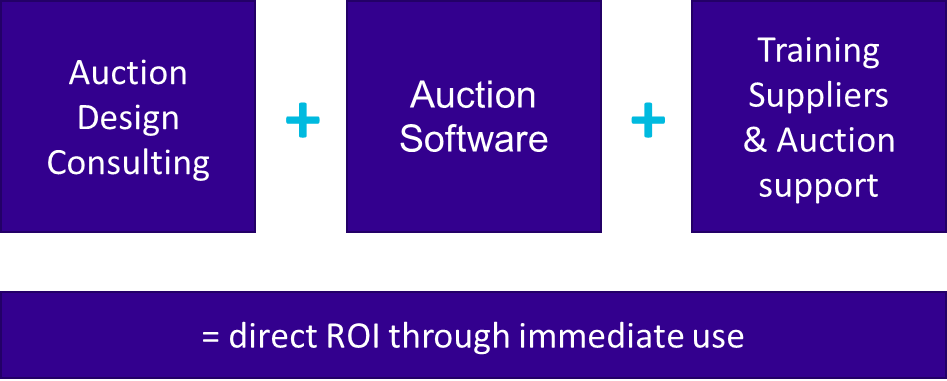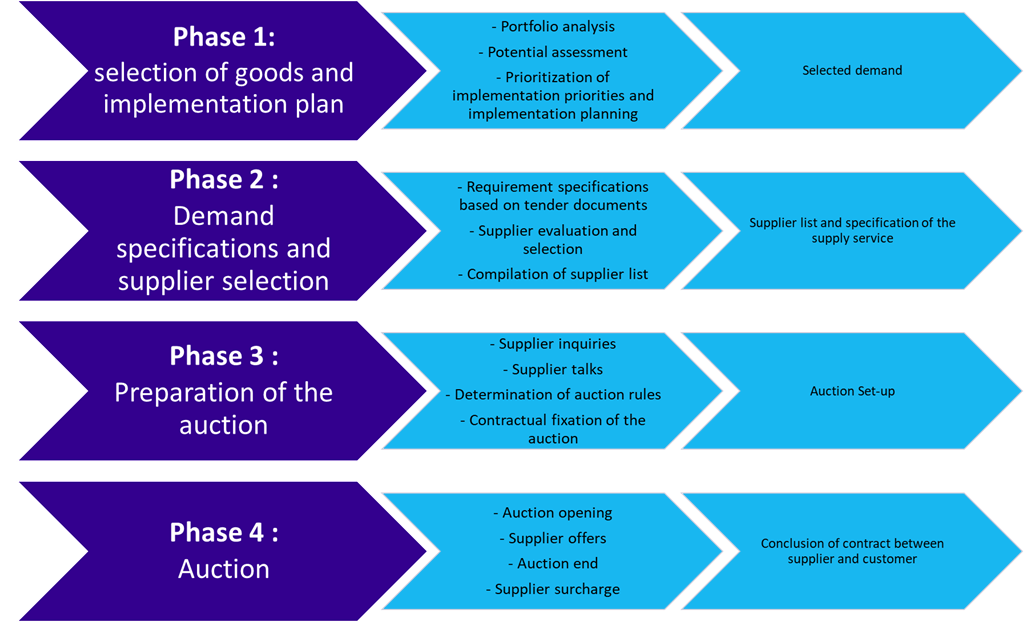Auction as a Service
Why e-auctions are a must in 2021
In economically challenging times, the main priority for purchasing is to reduce costs. Therefore, it is no wonder that the number of purchasing auctions as a negotiation option to award a tender is increasing. After all, competition at an auction can significantly reduce the purchase price.

Due to the increasing digitalization in the professional environment, auctions are no longer held as on-site, but are increasingly organized online. This is a positive development for the purchasing department – electronic auctions are extremely efficient, fast and also reduce process costs.
In digital purchasing, the “auction as a service” (AaaS) approach leads to significant cost and productivity efficiencies. Digitization in purchasing conserves budgets, saves time and strengthens transparency and thus compliance in companies.
What is Auction as a Service (AaaS)?
In the following we’ll explain what Auction as a Service is, if it’s suitable for your company and how you can successfully conduct an e-auction.
“Auctions as a Service” providers like Synertrade offer a digital, neutrally operated marketplace where suppliers and buyers come together under fixed rules. The process of AaaS service providers consists of three components:
- Auction design consulting,
- Auction software usage, and
- Training of suppliers & monitoring of the auction.

This process eliminates the need for complex software implementation. Employees do not need to be trained; the application is done via common browsers with one account.
It is billed per auction, which results in an immediate ROI (Return on Investment).
The goal of the online auction is to increase competition in a cost-effective manner. Suppliers can participate in an electronic auction regardless of their location and they can time limit the auction to quickly get the best possible price.
The success of e-auctions has already been proven: In the UK, the use of AaaS resulted in 15% cost savings for construction equipment and 14% savings for operational consumables.
For whom is Auction as a Service suitable?
In principle, online auctions are suitable for any sector or industry.
There are four factors that determine whether your RFP is suitable for an auction.
1. Number of suppliers
The goal of an e-auction is intense competition. However, if your market has a supplier monopoly or duopoly and suppliers do not compete vigorously with each other, it is not worth using an auction because it will not generate large cost savings.
On the other hand, if you are in a market that has a healthy number of competitors, you can achieve significant success with an e-auction.
2. Tender
The specifications must be described factually and in numbers so that a comparison can be made. Examples of this are delivery time or delivery quality.
Not every purchase process is suitable for an auction. If you cannot clearly describe your requirements, you should either select your suppliers using a different method or gather more information to make a clearer specification.
3. Spend volume
In order to make the effort of an auction procedure worthwhile, you should have a purchasing volume of more than 1 million Euro.
4. Shopping cart
Complex and diverse shopping carts raise questions that complicate the e-auction. Therefore, the number of shopping carts should remain below 20.
Advantages of Auction as a Service
In economics, a market that is completely transparent and independent of personal, temporal, factual, or spatial preferences is optimal because there are no arbitrage opportunities. The “Auction as a Service” model creates exactly these conditions.
- This brings several advantages. The intensification of the supplier’s competition creates optimal purchasing conditions that lead to a reduction in costs.
- The distance to the supplier ensures that no lobbying takes place and objectivity is increased. Transparency enables a better overall view of the market situation.
- The digitization of the auction process offers the possibility to filter quickly and easily by conditions, e.g. proximity to the supplier.
- Companies also benefit from savings in effort and time. The defined rules in the award process eliminate internal coordination loops. In addition, the disclosed price reduces the negotiation effort.
Success factors of an e-auction
There are seven steps to making your online auction successful:
1. Preparation
The key to success is a specific purchasing potential analysis that helps determine which material groups are auctionable and which groups need obstacles removed.
2. Specification
Except for price, all product characteristics should be specified precisely so that only cost remains as a variable.
3. Training
Through training programs and experts of the service provider, buyers are perfectly prepared for use by means of game situations with the help of the tool.
4. Building up assessment competence
You should build up your own assessment competence about the online marketplaces offered, so that you are protected against bad investments.
5. Experience of the service provider
Since the service provider is an important partner for the AaaS, he should have a high level of consulting competence and experience to guarantee the successful implementation.
6. Verifiability
A fair auction should guarantee the verifiability of rules and contracts – this requires a service provider with reputation and know-how.
7. Efficient use of the service provider
The AaaS tool should allow you to quickly assess strengths and weaknesses, as well as purchasing strategies of procurement goods and markets.
Auction forms with Auction as a Service
A cornerstone of Auction as a Service is the auction form. The auction form sets the rules for all participants. Depending on your requirements, specifications and market structure, different auction forms may be suitable for you.
English auction
In an English auction, the new bids must outbid the lowest bid. The lowest price is considered the winning bid.
Useful when … you have at least three different suppliers to choose from and there is little difference in product and pre-bids.
Rank-only auction
In the rank-only auction, the bidder only gets information about the rank of his own bid compared to other bidders and can undercut his own bid. The bidder does not have the possibility to get information about the current lowest competing bid.
Useful when … you want suppliers to remain anonymous.
TCO auction
TCO stands for “Total Cost of Ownership”. In this process, auctions are held not only on the final price of the product, but also on additional costs at the same time. The winning bid adds up over the TCO.
Useful when … the purchase is made up of various cost sources.
Dutch auction
The Dutch auction turns the tables on the English auction and starts with a low starting price. The price is continuously increased until the first supplier agrees to deliver at this price.
Useful when … there are strong differences in the bidders’ pre-bids and a quick decision needs to be made.
Japanese Auction
The Japanese auction has the same procedure as the Dutch auction, but it starts with a high price and then decreases continuously. The bidder with the lowest bid wins the auction.
Useful when … the buyer wants to know the best offers from all suppliers.
Procedure of an e-auction
Basically, an e-auction consists of four phases:

Phase 1: Selection of goods and implementation plan.
In this phase, portfolio analysis and potential assessment should lead to prioritization of implementation priorities and ultimately to an implementation plan.
Phase 2: Demand specifications and supplier selection
In Phase 2, a requirements specification should be developed based on specification documents. Suppliers should be evaluated. Thus, a supplier list should be compiled for the auction.
Phase 3: Preparation of the auction
Suppliers should be approached and prepared for the auction. The rules of the auction must now be defined and, along with this, the auction must be contractually fixed.
Phase 4: Auction
Now the auction is opened. The suppliers submit their bids, which are continuously evaluated. At the end of the auction, the winning supplier is awarded the contract, which is then concluded between the supplier and the customer.
Conclusion
Auction as a Service is already an integral part of purchasing and will become even more relevant in the future. Companies that have recognized this are already using the know-how and expertise from numerous implemented projects of Synertrade to efficiently reduce purchasing costs.
With its source-to-contract solution, Synertrade offers companies an Auction as a Service module that meets compliance and security requirements and is continuously adapted to the latest technological developments.
If you want to future-proof your purchasing, book a free consultation with us!
